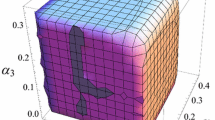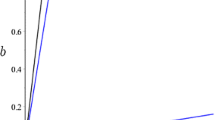Abstract
The recently developing theory of nonlinear dynamics shows that any economic model can generate a complex dynamics involving chaos if the nonlinearities become strong enough. This study constructs a nonlinear Cournot duopoly model, reveals conditions for the occurrence of chaos, and then considers how to control chaos. The main purpose of this paper is to demonstrate that chaos generated in Cournot competition is in a double bind from the long-run perspective: a firm with a lower marginal production cost prefers a stable (i.e., controlled) market to a chaotic (i.e., uncontrolled) market, while a firm with a higher marginal cost prefers the chaotic market.
Similar content being viewed by others
References
DAY, R., Irregular Growth Cycles, American Economic Review, Vol. 72. pp. 406–414, 1982.
BOLDRIN. M., and WOODFORD, M., Equilibrium Models Displaying Endogenous Fluctuations and Chaos: A Survey, Journal of Monetary Economics. Vol. 25. pp. 189–222, 1990.
MAJUMDAR, T., MITRA, T., and NISHIMURA, K., Optimization Chaos, Springer, New York, NY, 2000.
RAND, D., Exotic Phenomena in Games and Duopoly Models, Journal of Mathematical Economics, Vol. 5, pp. 173–184, 1978.
KOPEL, M., Simplex and Complex Adjustment Dynamics in Cournol Duopoly Models, Chaos, Solitons, and Fractals, Vol. 7, pp. 2031–2048, 1996.
PUU, T., Attractors, Bifurcations, and Chaos: Nonlinear Phenomena in Economics, Springer, New York, NY, 2000.
PUU, T., and SUSHKO, I., Oligopoly Dynamics: Models and Tools, Springer, New York, NY, 2002.
KOPEL, M., Improving the Performance of an Economic System: Controlling Chaos, Journal of Evolutionary Economics, Vol. 7, pp. 269–289, 1997.
KASS, L., Stabilizing Chaos in a Dynamic Macroeconomic Model, Journal of Economic Behavior and Organization, Vol. 33, pp. 313–332, 1998.
BALA, V., MAJUMDAR, M., and MITRA, T., A Note on Controlling a Chaotic Tatonnement, Journal of Economic Behavior and Organization, Vol. 33, pp. 411–120, 1998.
MENDES, V., and MENDES, D., Control of Hyperchaos in an OLG Economic Model. Unpublished Paper, 2000.
HUANG, W. H., Cautious Implies Profit, Journal of Economic Behavior and Organization. Vol. 29, pp. 257–277, 1995.
MATSUMOTO, A., and NONAKA, Y., Statistical Dynamics in Chaotic Cournot Model with Complementary Goods, Journal of Economic Behavior and Organization, 2004.
DANA, R. A., and MONTRUCCHIO, L., Dynamic Complexity in Duopoly Games, Journal of Economic Theory, Vol. 40, pp. 40–56, 1986.
DAY, R., Complex Economic Dynamics, MIT Press, Cambridge, Massachusetts, 1994.
UETA, T., and KAWAKAMI, H., Composite Dynamic System for Controlling Chaos, IEICE Transactions on Fundamentals, Vol. E78-A(6), pp. 708–714, 1995.
ROMEIRAS, F. J., GREBOGI, C., OTT, E., and DAYAWANA, W. P., Controlling Chaotic Dynamical Systems, Physica D, Vol. 58, pp. 165–192, 1992.
OKUGUCHI, K., and SZIDAROVSZKY, F., The Theory of Oligopoly with Multiproduct Firms, 2nd Edition, Springer, New York, NY, 1999.
Author information
Authors and Affiliations
Additional information
Helpful remarks and comments by Ferenc Szidarovszky, Michael Kopel, Shahriai Yousefi, and three anonymous referees are gratefully acknowledged. Financial support from the Japan Ministry of Education, Culture, Sports, Science, and Technology, Grant-in-Aid for Scientific Research (B)15330037, and from Chuo University, Joint Research Grant 0382, is highly appreciated.
Rights and permissions
About this article
Cite this article
Matsumoto, A. Controlling the Cournot-Nash Chaos. J Optim Theory Appl 128, 379–392 (2006). https://doi.org/10.1007/s10957-006-9021-z
Published:
Issue Date:
DOI: https://doi.org/10.1007/s10957-006-9021-z




